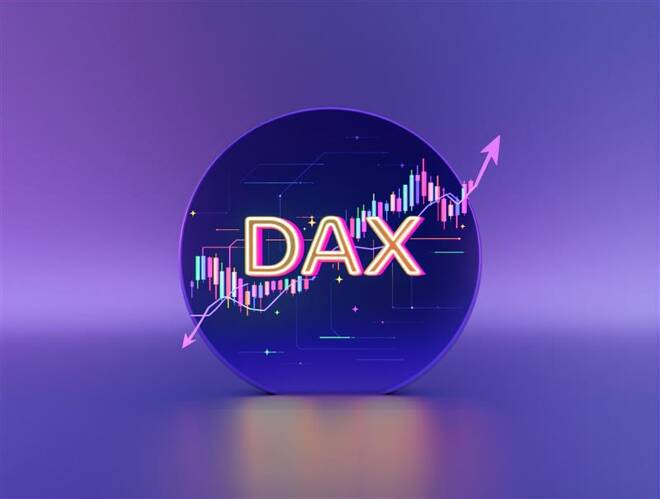Advertisement
Advertisement
Dax Index News: Forecast Eyes 21,500 as Tariff Easing Fuels Bullish Momentum
By:
Key Points:
- DAX futures jump over 500 points, signaling bullish momentum ahead of key PMI and trade policy updates.
- US-EU tariff silence and US-China trade thaw boost risk appetite across global markets.
- Weak German and Eurozone PMIs may raise recession risks and increase pressure on ECB for rate cuts.
DAX Edges Higher as Tariff Calm Fuels Risk Appetite Ahead of PMI Data
European equity markets resumed trading on a positive note Tuesday, April 21, with the DAX climbing 0.41% to 21,294 amid a temporary lull in tariff rhetoric. Investor sentiment improved on hopes of a breakthrough in US-EU trade discussions, driving demand for German-listed stocks.
However, lingering uncertainties over monetary policy and muted global growth expectations capped gains as markets braced for key economic indicators midweek.
Notably, the IMF cut its 2025 growth forecasts, attributing the revision to US tariffs. The IMF expects the German economy to stagnate in 2025, with growth forecast at 0.9% in 2026, down 0.3 and 0.2 percentage points, respectively.
Autos Shine on Tariff Hopes
German automakers rallied on April 22, driven by optimism that President Trump may delay auto tariffs.
Volkswagen rallied 3.04%, with Porsche (+2.96%), Mercedes-Benz Group (+2.37%), and BMW (+2.16%) also rising.
Meanwhile, SAP slid 3.32% despite topping earnings forecasts. The firm warned that an escalation in trade tensions could impact the outlook.
Eurozone Consumer Sentiment Wanes
Consumer confidence weakened in April, reflecting growing concerns about US tariffs and the broader economy. The Eurozone Consumer Confidence Index dropped to -16.7 in April, down from -14.5 in March.
Weaker confidence could impact consumer spending and services sector activity, supporting a more dovish ECB stance.
Private Sector PMIs to Spotlight Tariffs
Flash private sector PMIs on Wednesday, April 23, will likely reflect the early effects of US tariffs on economic conditions. Economists expect Germany’s HCOB Services PMI to fall from 50.9 in March to 50.2 in April. The Manufacturing PMI is forecast to drop from 48.3 to 47.6.
Weaker-than-expected PMIs could fuel recession fears, supporting multiple ECB rate cuts, though demand for risk assets may hinge on investor sentiment.
US Markets Rally as Trump U-Turns on China
US equity markets rebounded on Tuesday, April 22, after President Trump softened his tone on China tariffs. The Nasdaq Composite Index jumped 2.71%, while the Dow and the S&P 500 rallied 2.66% and 2.51%, respectively.
A potential thaw in US-China trade relations buoyed market sentiment and hinted at a broader shift in the White House’s approach. Trump also moved to ease concerns over Fed independence.
The Kobeissi Letter commented on the overnight developments, stating:
“Trump is now claiming that tariffs on China will come down from 145%. It seems like tariffs are set to come down and Powell is staying (for now).”
While stating that tariffs will drop, Trump reportedly clarified that tariffs won’t drop to zero but will be significantly lower, setting a positive tone for the April 23 European session.
US Private Sector PMIs, the Fed, and Trump in Focus
On Wednesday, April 23, US private sector PMIs will give insights into the US economy. Economists expect the crucial S&P Global Services PMI to drop to 52.8 in April, down from 54.4 in March. A sharper drop could renew concerns over slowing growth and weigh on equities.
Conversely, an unexpected pickup in service sector activity may ease recessionary fears, bolstering risk sentiment.
Ongoing trade developments will also remain in focus—de-escalation may counterbalance weak PMI data, while new tensions could pressure German stocks.
Near-Term Outlook: DAX Sensitivity to Macro Risks
The DAX’s near-term trajectory will depend on private sector PMIs, central bank guidance, and tariff-related headlines.
Potential DAX Scenarios:
- Bullish Case: Easing trade tensions, upbeat private sector PMIs, or dovish central bank commentary could push the DAX toward 21,500.
- Bearish Case: Rising trade tensions, weaker PMI data, or hawkish central bank rhetoric may pull the DAX toward 20,500.
As of Wednesday morning, the DAX futures were up 516 points, while the Nasdaq 100 mini gained 335 points, indicating a breakout start to the session.
Technical Warning Signs Flash
Daily Chart:
After Tuesday’s gains, the DAX trades above the 200-day Exponential Moving Average (EMA) but remains below the 50-day EMA, indicating the uptrend lacks short-term confirmation.
- Upside Target: A break above 21,500 could pave the way to the 50-day EMA, with 22,000 as the next key resistance level.
- Downside risk: A drop below 21,000 could enable the bears to target the 200-day EMA, with 19,675 as the next support level.
Conclusion: Monitor Macro Themes
Trade policy shifts, PMI releases, and central bank signals will remain key drivers of DAX performance.
Explore our latest research here for more insights into the DAX, macro trends, and emerging market opportunities.
About the Author
Bob Masonauthor
With over 28 years of experience in the financial industry, Bob has worked with various global rating agencies and multinational banks. Currently he is covering currencies, commodities, alternative asset classes and global equities, focusing mostly on European and Asian markets.
Did you find this article useful?
Latest news and analysis
Advertisement
